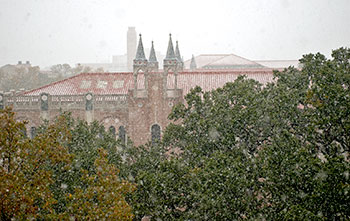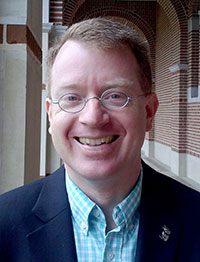Over the winter break, Facilities Engineering and Planning (FE&P) will enact a series of measures to reduce energy consumption in some of the campus buildings. Called “setbacks,” these measures will be in place from the evening of Dec. 24 through Jan. 3; they will not impact labs.
“The winter break is a prime opportunity for the university to significantly reduce its energy consumption,” said Richard Johnson, director of Rice’s Administrative Center for Sustainability and Energy Management. “It’s something we’ve done for several years, and in fact, we estimated that last year’s winter setbacks saved the university approximately $47,000.”
The holiday setback routine is in effect when outdoor temperatures are between 40 and 75 degrees Fahrenheit. If outdoor temperatures go outside this range, the heating, ventilation and air conditioning (HVAC) systems will resume normal operations. Also, the holiday settings monitor indoor conditions; if indoor temperatures start to get too high or too low, the building HVAC systems will resume normal operations until the indoor temperatures are back within an acceptable range.
Buildings included in this holiday setback are listed below. FE&P is working with Housing and Dining to identify appropriate setbacks for the residential colleges. Employees who need to be in their office during the break can call the Facilities Service Center at 713-348-2485 if they need adjustments to the temperature in their work space .
Rice also requests employees consider taking extra steps to help reduce campus power consumption during the winter break by shutting down, powering off and unplugging computers, copiers and other nonessential electronic equipment. If the plug is reasonably accessible, the device should be unplugged as well since many devices still draw a little bit of power when they are turned off but still plugged in.
“Rice is a community-minded place, and we all feel a direct connection to Rice’s mission, and we understand that every dollar we spend on utilities is a dollar that’s not available to support that mission,” Johnson said.
Total campus energy use is down by 5.7 percent between FY14 and FY15, Johnson said, thanks to many energy-saving measures, including setbacks and investments like the building-level energy conservation project in the Space Science Building that is nearly complete. Early results are showing substantial reductions in the use of energy for air conditioning and heating, he said.
“My colleagues John Windham and Eric Valentine (in FE&P’s Administrative Center for Sustainability and Energy Management) have been working on improving the building HVAC schedules so that we’re not providing so much cooling or heating during the middle of the night in nonlaboratory areas when we don’t need it,” Johnson said. “Our plant director, Hugh Ton-That, has overseen numerous maintenance projects that in aggregate improve the efficiency of the Central Plant.”
Energy efficiency also results from buildings that have received certification from the U.S. Green Building Council’s Leadership in Energy and Environmental Design (LEED) program. Anderson-Clarke Center, home of the Susanne M. Glasscock School for Continuing Studies and Rice’s first building with all-LED lighting, is the most recent building to be certified LEED Gold. LEED certification is an internationally recognized standard for the design, construction and operation of eco-friendly buildings. It is awarded to projects designed and built to universally accepted criteria for energy efficiency, material conservation, water efficiency, indoor environmental quality and stewardship of resources and sensitivity to their impacts. (Watch for a story about the Anderson-Clarke Center’s LEED certification in an upcoming Rice News.)
Even small-scale changes are being made on campus to make a difference: In the commons at Hanszen College, students are working to install LED lighting.
“And now that we are deliberately procuring some of our electricity from an off-campus solar array at no additional cost, not only are we using less, but what we are using is ‘greener’ too,” Johnson said. “Plus Mark Ditman of Housing and Dining led the installation of a solar array on top of the south wing of Jones College.
“We appreciate the campus’s partnership as we take these steps to manage our energy more efficiently, to reduce Rice’s utility costs and to cut our greenhouse gas emissions,” Johnson said.
For more information about sustainability at Rice, visit http://sustainability.rice.edu/.
Buildings included in the holiday setback:
- Abercrombie, second floor only.
- Alice Pratt Brown, limited to areas approved by building manager.
- Allen Center.
- Anderson Biology, auditorium only.
- Anderson-Clarke Center for Continuing Studies.
- Anderson Hall, excluding rooms 143, 144, 154, 201, 217, 218 and 238.
- Baker Institute, excluding zones serving audio/visual rooms (rooms 153, 155, 157, 180A and 330).
- Brochstein Pavilion, from Dec. 14 to Jan. 16.
- Cohen House, from Dec. 22 to Jan. 3.
- Duncan Hall, except for Room 3078 and others on its zone.
- Facilities Engineering and Planning.
- Fondren Library, excluding Room B50.
- Gibbs Recreation and Wellness Center, excluding areas in the Rec Center wing identified by building manager.
- Greenbriar, except telephone and IT rooms.
- Hamman Hall.
- Herman Brown, except the server room.
- Herring Hall.
- Herzstein Hall, office and classroom areas only.
- Humanities Building.
- Lovett Hall.
- McNair Hall.
- Rayzor Hall.
- Rice Memorial Center/Ley Student Center, excluding the Rice Chapel and KTRU and excluding Grand Hall beginning Dec. 26.
- Sewall Hall.




Leave a Reply